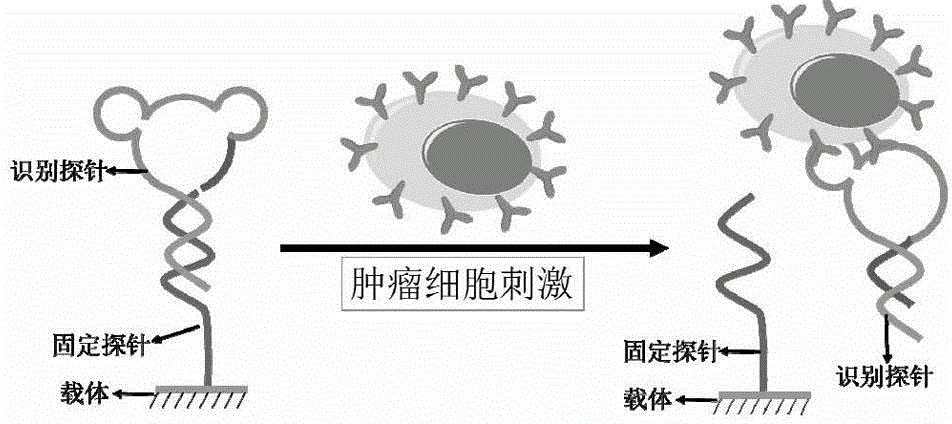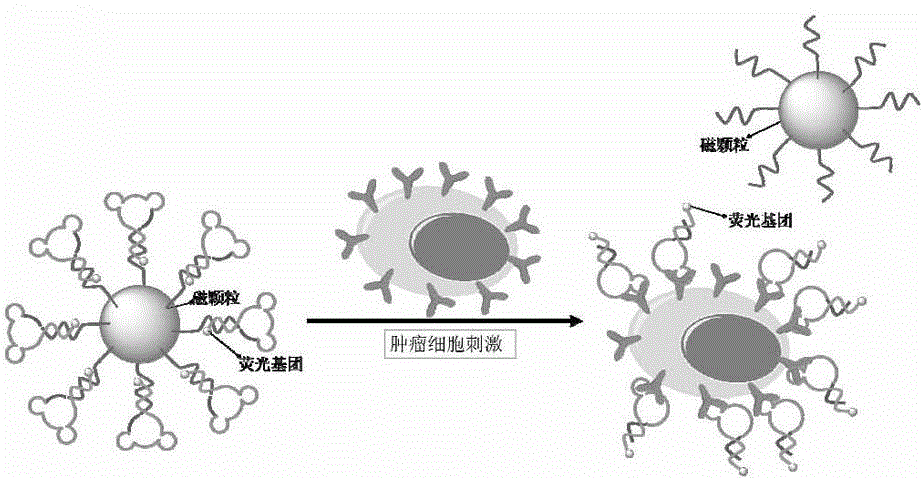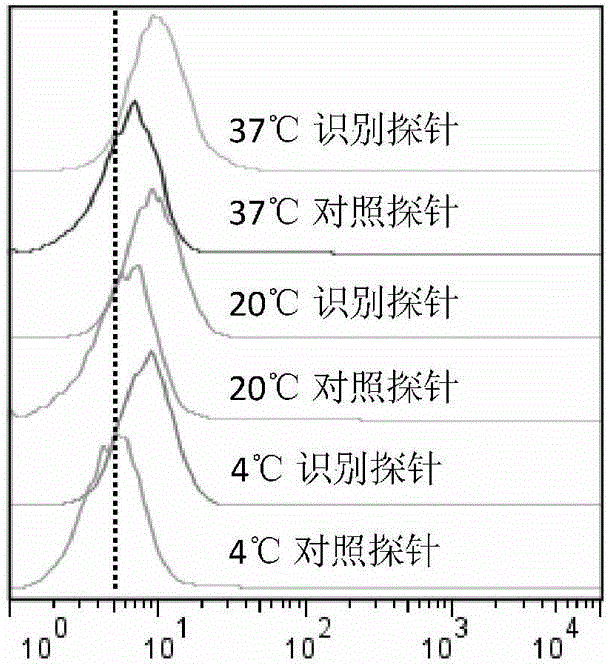Nucleic acid aptamer probe and device for cancer cell detection and application of nucleic acid aptamer probe and device for cancer cell detection
A nucleic acid aptamer and tumor cell technology, which is applied in specific-purpose bioreactors/fermenters, biochemical cleaning devices, enzymology/microbiology devices, etc., can solve problems such as high cost, time-consuming, and complicated operations , to achieve the effect of low cost, low instrument requirements, and strong universality
- Summary
- Abstract
- Description
- Claims
- Application Information
AI Technical Summary
Problems solved by technology
Method used
Image
Examples
Embodiment 1
[0038] see figure 1 : A kind of device that is used for tumor cell detection of the present invention, comprises nucleic acid aptamer probe and carrier, wherein nucleic acid aptamer probe comprises immobilized probe, recognition probe, and immobilized probe 3' end is modified with biotin, The 5' end is modified with a quenching group BHQ1, and the 3' end of the recognition probe is modified with a fluorescent group FAM; the carrier is a superparamagnetic magnetic particle coated with streptavidin.
[0039] The nucleotide sequence of the fixed probe has the nucleotide sequence described in SEQ ID NO.1; specifically:
[0040]Immobilized Probe-CEM: 5'-BHQ1-TCT AAC CGT ATT TTT TTT TT -biotin-3'.
[0041] The nucleotide sequence of the recognition probe is the nucleotide sequence described in SEQ ID NO.2; specifically:
[0042] Recognition probe-CEM: 5'-ATC TAA CTG CTG CGC CGC CGG GAA AAT ACT GTA CGG TTA GA-FAM-3'.
[0043] The TCT AAC CGTA fragment of the immobilized probe-CEM ...
Embodiment 2
[0063] A device for tumor cell detection of the present invention comprises a nucleic acid aptamer probe and a carrier, wherein the nucleic acid aptamer probe includes an immobilized probe and a recognition probe, and the 3' end of the immobilized probe is modified with biotin, The 5' end of the recognition probe is modified with a fluorescent group FAM; the carrier is a superparamagnetic particle coated with streptavidin.
[0064] The nucleotide sequence of the fixed probe has the nucleotide sequence described in SEQ ID NO.3; specifically:
[0065] Immobilized Probe-7721: 5'-CGC GCG CTT TTT TTT TTT -biotin-3'.
[0066] The nucleotide sequence of the recognition probe is the nucleotide sequence described in SEQ ID NO.4; specifically:
[0067] Recognition probe-7721: 5'-FAM-AAA GCG CGC GCG CGC ATA GCG CGC TGA GCT GAA GAT CGT ACC GTG AGC GCG CT-3'.
[0068] The CGC GCG CTT T fragment of the immobilized probe is hybridized with the AAA GCG CGC G fragment in the recognition prob...
Embodiment 3
[0088] see Figure 7 : A device for tumor cell detection of the present invention, comprising a nucleic acid aptamer probe and a carrier, wherein the nucleic acid aptamer probe includes a fixed probe and a recognition probe, and the 3' end of the fixed probe is modified with biotin , the identification probe carries a medical contrast agent; the carrier is a microfluidic chip (the carrier can also be artificial blood vessels, vascular stents and other microchannels). The medical contrast agent used in this embodiment is pyropheophorbide-a, and the microfluidic chip is a microfluidic chip bonded between PDMS polymer and glass.
[0089] The nucleotide sequence of the fixed probe has the nucleotide sequence described in SEQ ID NO.3; specifically:
[0090] Immobilized Probe-7721: 5'-CGC GCG CTT TTT TTT TTT -biotin-3'.
[0091] The nucleotide sequence of the recognition probe is the nucleotide sequence described in SEQ ID NO.4; specifically:
[0092] Recognition probe-7721: 5'-F...
PUM
 Login to View More
Login to View More Abstract
Description
Claims
Application Information
 Login to View More
Login to View More - R&D
- Intellectual Property
- Life Sciences
- Materials
- Tech Scout
- Unparalleled Data Quality
- Higher Quality Content
- 60% Fewer Hallucinations
Browse by: Latest US Patents, China's latest patents, Technical Efficacy Thesaurus, Application Domain, Technology Topic, Popular Technical Reports.
© 2025 PatSnap. All rights reserved.Legal|Privacy policy|Modern Slavery Act Transparency Statement|Sitemap|About US| Contact US: help@patsnap.com



